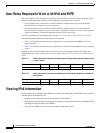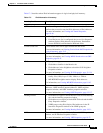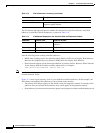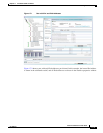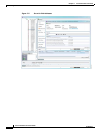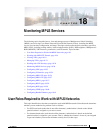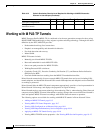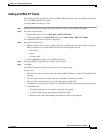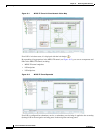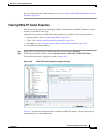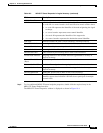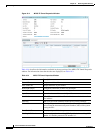
18-4
Cisco Prime Network 4.0 User Guide
OL-29343-01
Chapter 18 Monitoring MPLS Services
Working with MPLS-TP Tunnels
Working with MPLS-TP Tunnels
MPLS-Transport Profile (MPLS-TP) is considered to be the next generation transport for those using
SONET/SDH TDM technologies as they migrate to packet-switching technology. Although still under
definition by the IETF, MPLS-TP provides:
• Predetermined and long-lived connections.
• Emphasis on manageability and deterministic behavior.
• Fast fault detection and recovery.
• Inband OAM.
MPLS-TP features include:
• Manually provisioned MPLS-TP LSPs.
• Reserved bandwidth for static MPLS-TP LSPs.
• One-to-one path protection for MPLS-TP LSPs.
• Working/Protected LSP switchover.
• Continuity Check (CC), Proactive Continuity Verification (CV), and Remote Defect Indication
(RDI) based on BFD.
• New fault OAM functions resulting from the MPLS-TP standardization effort.
Prime Network automatically discovers network MPLS-TP tunnels from end to end, including LSPs,
tunnel endpoints, and bandwidth. Network LSPs contain LSP endpoints and midpoints and are identified
as working or protected.
Prime Network links the MPLS-TP tunnel components appropriately, provides a visual representation in
Prime Network Vision maps, and displays the properties in logical inventory.
Prime Network employs warm start technology when rebooting. That is, when rebooting, Prime Network
compares existing MPLS-TP tunnel information to topology changes that occur while Prime Network is
down and updates MPLS-TP tunnel accordingly when Prime Network returns to operation.
The following options are available for working with MPLS-TP tunnels in Prime Network Vision:
• Adding an MPLS-TP Tunnel, page 18-5
• Viewing MPLS-TP Tunnel Properties, page 18-7
• Viewing LSPs Configured on an Ethernet Link, page 18-11
• Viewing LSP Endpoint Redundancy Service Properties, page 18-14
• Applying an MPLS-TP Tunnel Overlay, page 18-16
• Viewing MPLS-TP BFD session properties—See Viewing BFD Session Properties, page 18-47.
View port configurations X X X X X
View pseudowire end-to-end
emulation tunnels
XX X X X
Table 18-2 Default Permission/Security Level Required for Working with MPLS Networks -
Element in User’s Scope (continued)
Task Viewer Operator OperatorPlus Configurator Administrator



